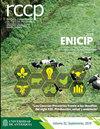羔羊用Pequi副产物:生产性能、采食量和营养物质消化率
IF 0.5
4区 农林科学
Q4 AGRICULTURE, DAIRY & ANIMAL SCIENCE
引用次数: 0
摘要
背景:使用pequi副产品作为动物饲料是降低总体生产成本的一种有吸引力的替代方案。然而,人们对其对动物表现的影响以及饮食中的理想包含水平知之甚少。目的:评价日粮中含有不同水平的pequi副产物作为玉米青贮饲料的部分替代品的圈养羔羊的性能、摄入量和消化率。方法:实验在巴西库韦洛进行,用25只6个月大的Santa inês公羊羔(17.83±1.73公斤)杂交92天。在一项完全随机的设计中,评估了取代玉米青贮饲料的pequi副产品(0、6、12、18和24%)水平的增加。进行方差分析和回归分析,具有5%的显著性水平。结果:pequi副产物的加入对平均日增重、总增重或饲料转化率没有影响(p>0.05)。干物质、有机物、乙醚提取物、粗蛋白质、中性洗涤纤维、总碳水化合物和总可消化营养素的摄入量也没有影响(p>0.05)。然而,随着pequi副产物含量的增加,干物质、有机物、醚提取物、粗蛋白、中性洗涤纤维、总碳水化合物和总可消化营养素的表观消化率呈线性下降(p<0.05)。结论:Pequi副产物是羔羊日粮中玉米青贮饲料的潜在替代品,因为它不会影响动物的生产性能和采食量。然而,随着日粮中pequi副产物含量的增加,消化率降低。本文章由计算机程序翻译,如有差异,请以英文原文为准。
Pequi (Caryocar brasiliense Camb.) by-product for lambs: performance, feed intake, and nutrient digestibility
Background: The use of pequi by-product as animal feed is an appealing alternative to reduce overall production costs. However, little is known regarding its effects on animal performance as well as the ideal inclusion level in the diet. Objective: To evaluate performance, intake, and digestibility of confined lambs receiving diets containing different levels of pequi byproduct as a partial substitute for corn silage. Methods: The experiment was conducted in Curvelo, Brazil, using twenty-five crossbred Santa Inês male lambs (17.83 ± 1.73 kg) aged six months for 92 days. Increasing levels of pequi by-product (0, 6, 12, 18, and 24%) replacing corn silage were evaluated in a completely randomized design. Analysis of variance and regression were performed, with 5% significance level. Results: Inclusion of pequi by-product did not influence (p>0.05) average daily gain, total weight gain, or feed conversion ratio. No effect (p>0.05) was also observed on intake of dry matter, organic matter, ether extract, crude protein, neutral detergent fiber, total carbohydrates, and total digestible nutrients. However, a linear decrease was observed (p<0.05) in the apparent digestibility of dry matter, organic matter, ether extract, crude protein, neutral detergent fiber, total carbohydrates, and total digestible nutrients with increasing inclusion of pequi by-product. Conclusion: Pequi by-product is a potential substitute for corn silage in lamb diets because it does not influence animal performance and feed intake. However, digestibility decreases with increasing dietary inclusion levels of pequi by-product.
求助全文
通过发布文献求助,成功后即可免费获取论文全文。
去求助
来源期刊

Revista Colombiana De Ciencias Pecuarias
AGRICULTURE, DAIRY & ANIMAL SCIENCE-
CiteScore
0.80
自引率
0.00%
发文量
18
审稿时长
6-12 weeks
期刊介绍:
The editors of Revista Colombiana de Ciencias Pecuarias (RCCP) welcome the submission of original manuscripts on experimental and clinical studies associated with the broad areas of animal sciences and veterinary medicine as they interface with biochemistry, molecular biology, physiology, pharmacology, toxicology, pathology, microbiology, parasitology, immunology and epidemiology. The scope of the journal includes studies of basic and applied research in animal management and production, feeding and nutrition, reproduction, breeding, genetics, animal welfare and behavior; as well as animal production focussed from biotechnology, soil science, agrostology, silvopastoral systems, livestock economics and the environment.
The criteria for acceptance of papers submitted for publication are originality, quality and clarity of the content. Each contribution must be based on original, unpublished research that has not been simultaneously submitted to other journals. All papers will be peer reviewed. All authors bear responsibility for ensuring the integrity and quality of their reported research. It is the author''s responsibility to secure permission to use figures or tables that have been published elsewhere.
Contributions may be classified as original research, review, rapid communication, clinical case studies or methodological articles, as well as news/commentaries or letters to the editor. Most review articles are invited by the editor. Authors interested in submitting a review article should contact the corresponding editor. Rapid publication of original manuscripts is a goal of the journal. Manuscripts must be written in English. Each manuscript is considered for publication with the understanding that it has not been simultaneously submitted to any other journal. Upon acceptance for publication, papers are subject to editorial review and revision.
 求助内容:
求助内容: 应助结果提醒方式:
应助结果提醒方式:


